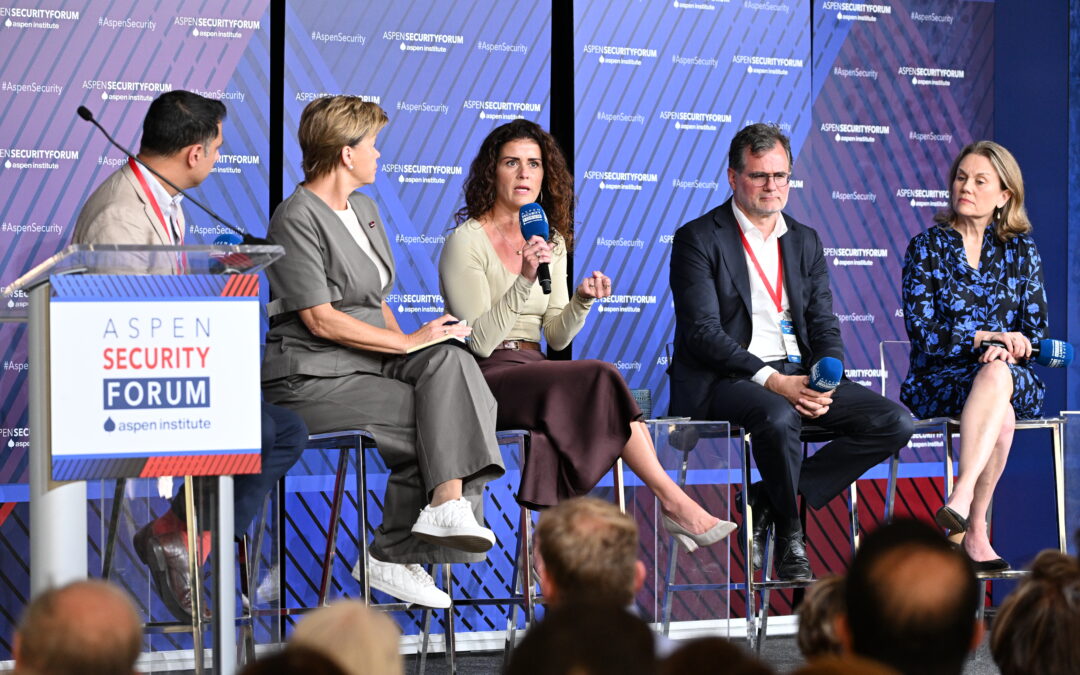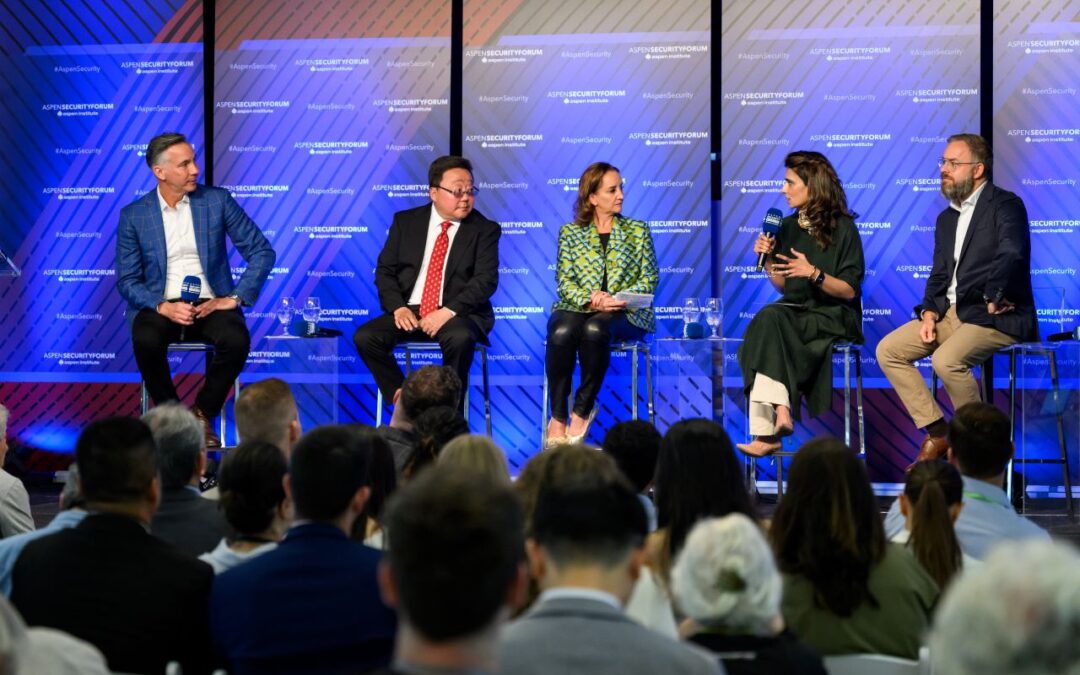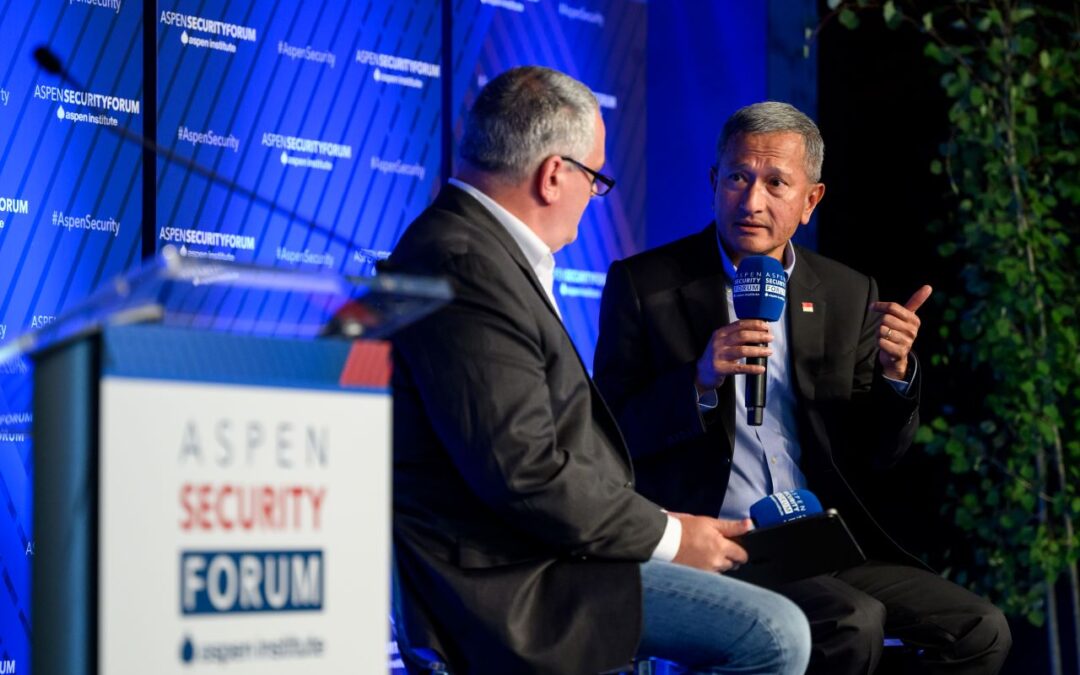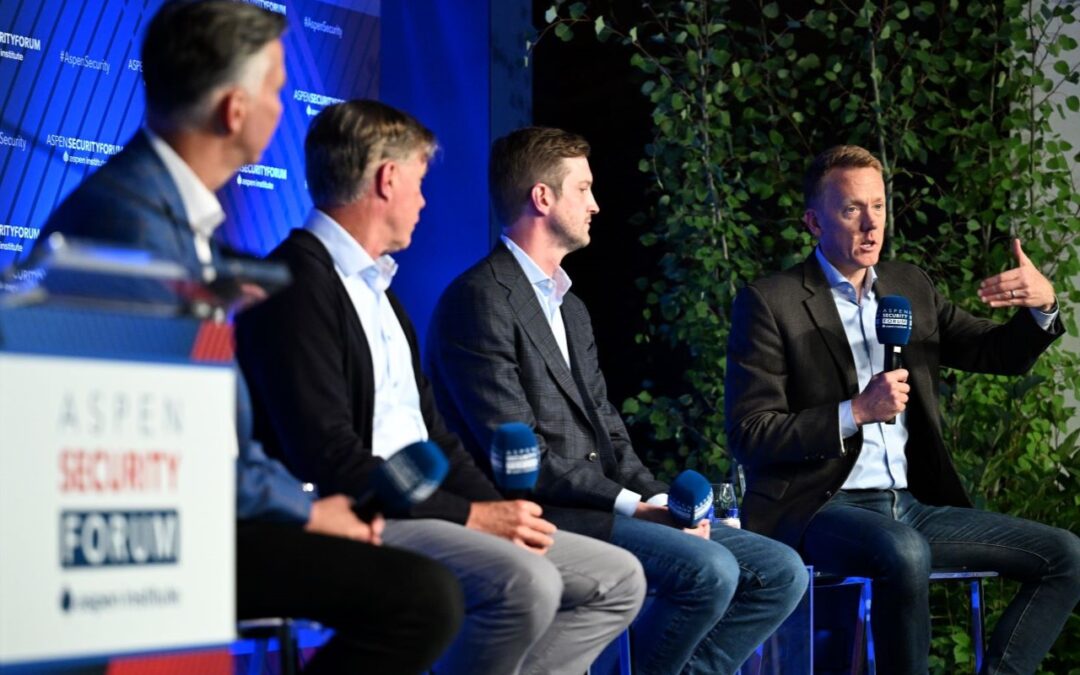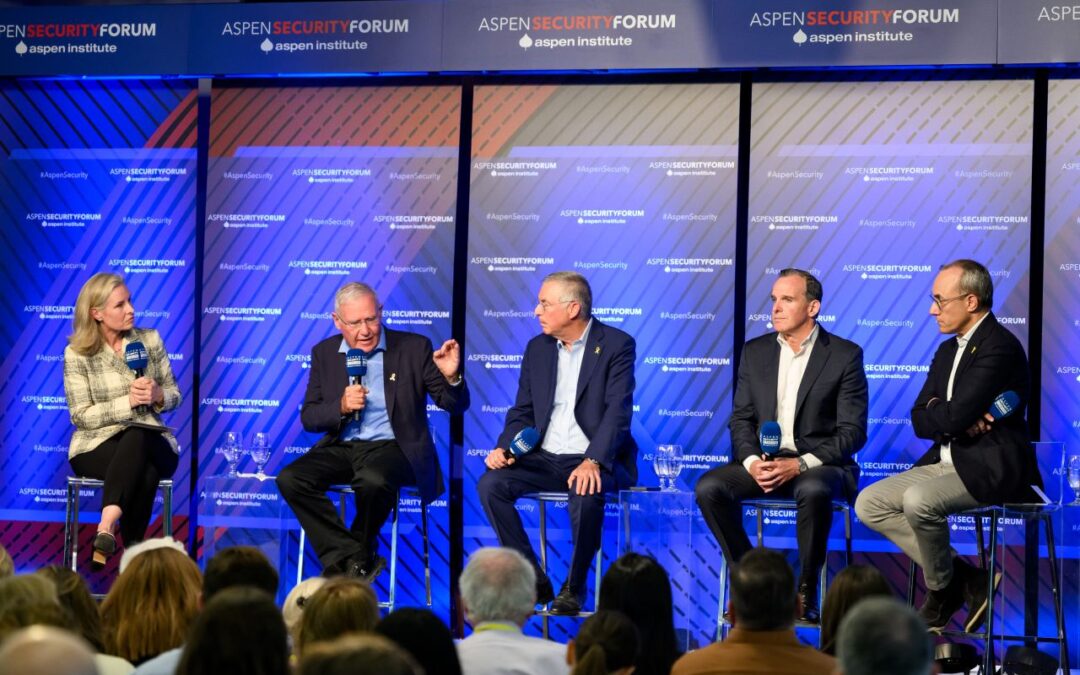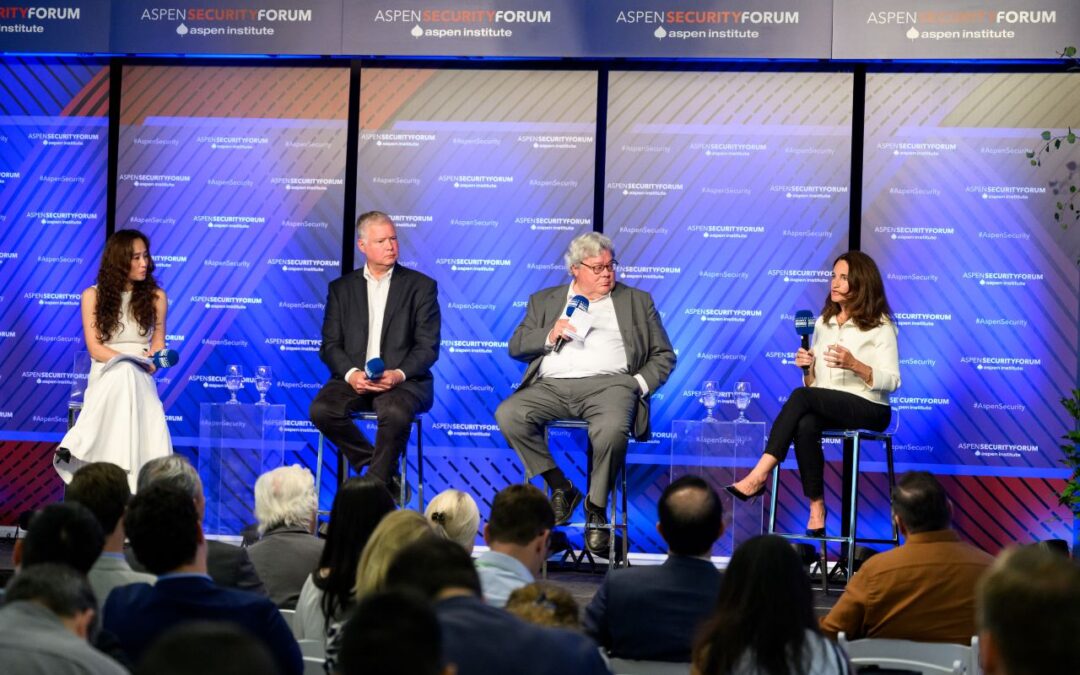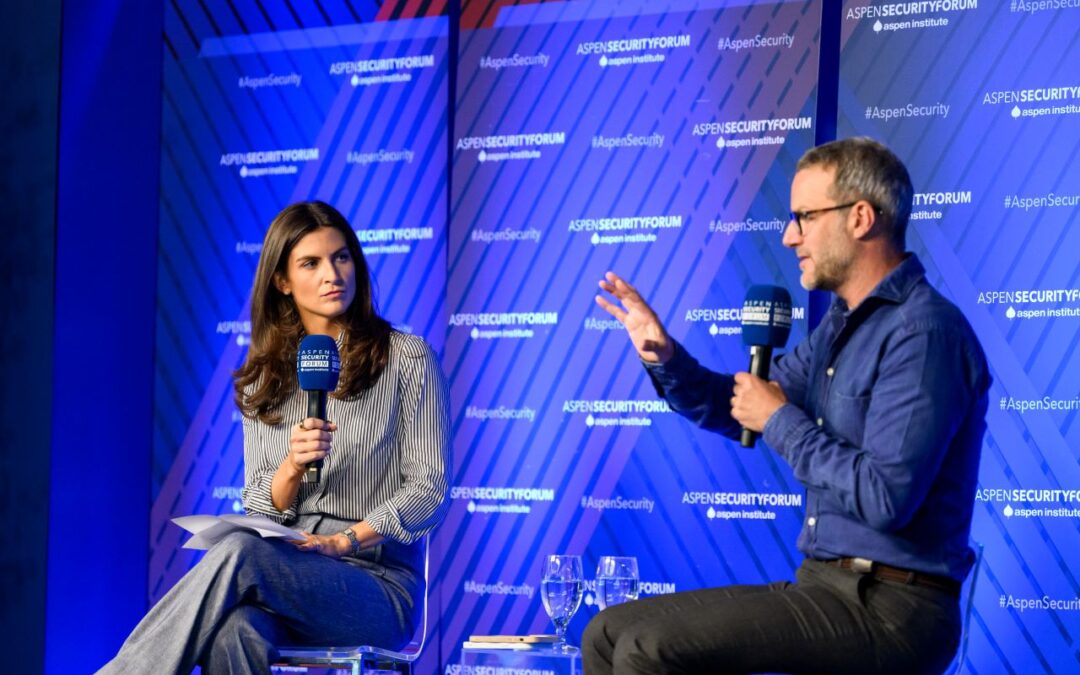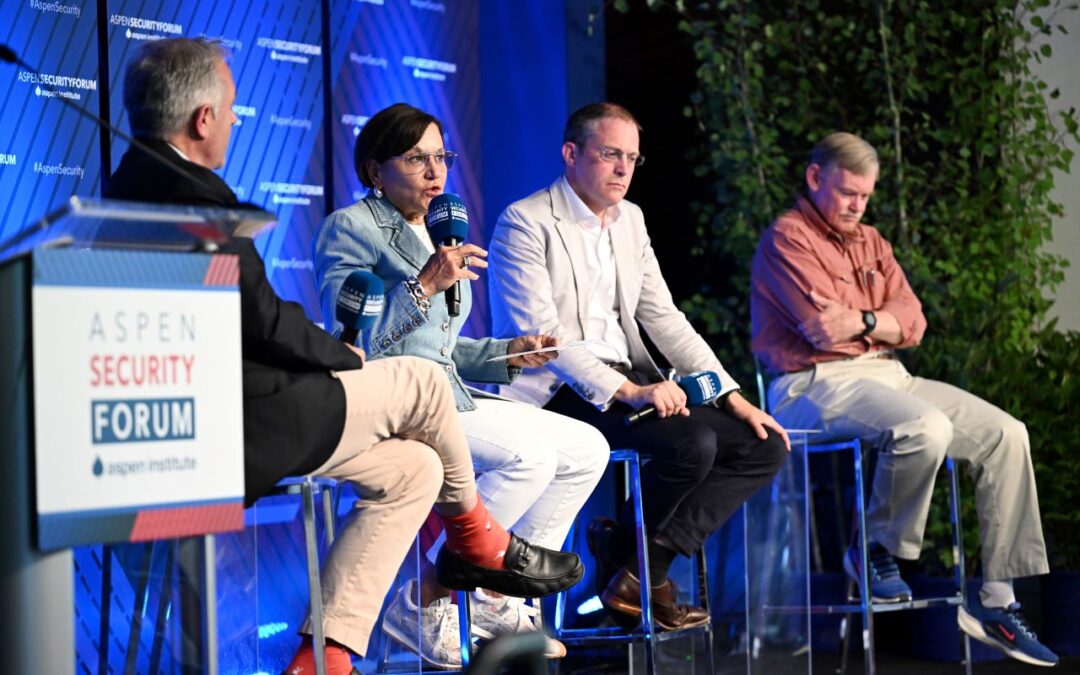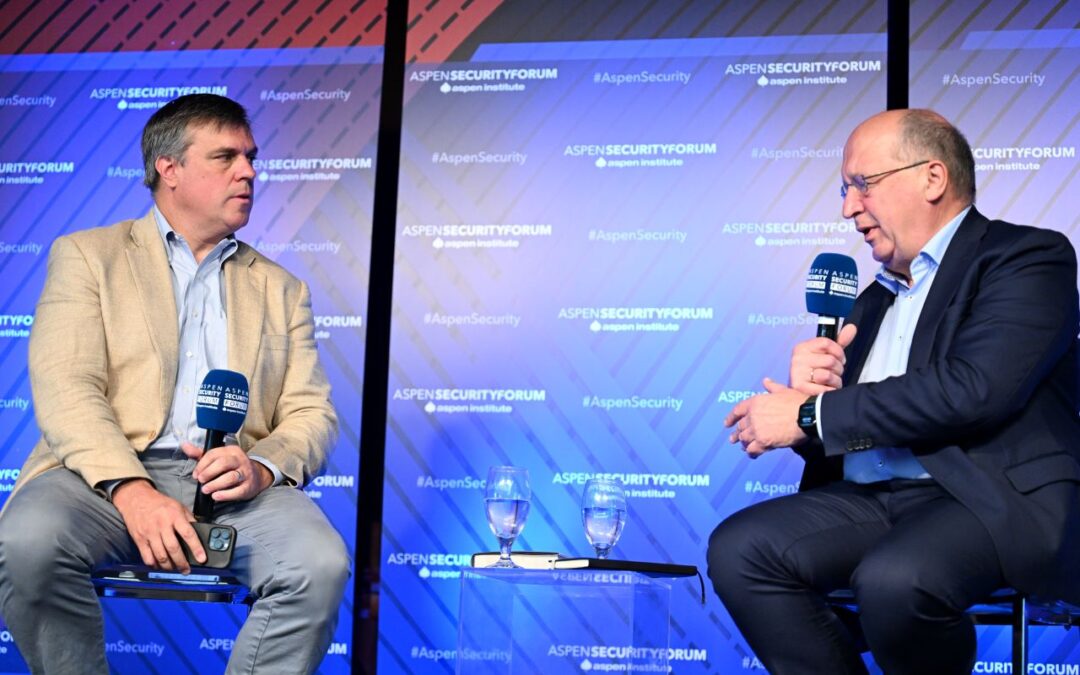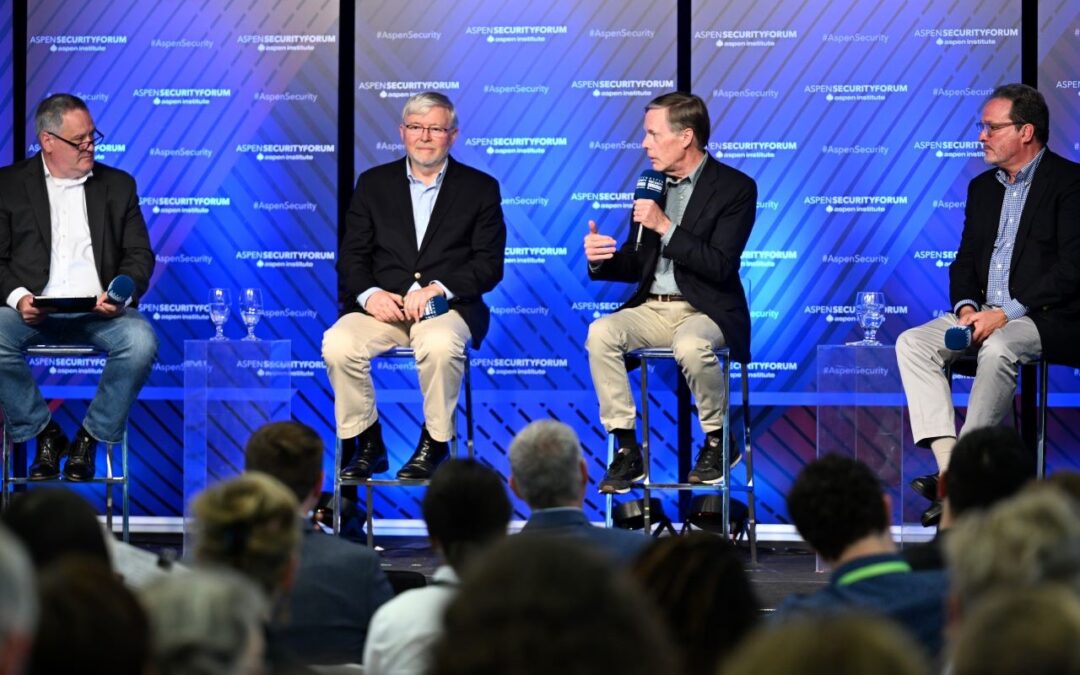Speakers
General James H. Dickinson, Commander, U.S. Space Command
Moderator: David Ignatius, Columnist, The Washington Post
Full Transcript
Read the full transcript below or download it to your device.
Click to read the full transcript
David Ignatius
It’s a pleasure to welcome General James Dickinson as combatant commander for spacecom. He is to space as Admiral Aquilino is to the Indo Pacific, which is quite a quite a challenge. So fun fact about General Dickinson. He went to elementary school here in Aspen which leads me to wonder why he ever left but I’m gonna I’m gonna pass on to part of why we’re all here to talk about space I want to begin by asking you about the heart of your mission space is now as we often repeat that contested domain and we read reports, publications that cover space CSIS annual space threat assessment about some of the things that the Chinese and Russians are doing with satellites in space that could attack our space infrastructure. You and I talked a little bit before the session about the Chinese SH 21. What it can do the Russian Petrushka nest nested satellites what they can do in terms of attack. Just give our audience a sense of what’s up there and what part of our potential adversaries it could do.
James Dickinson
Well, certainly, first of all, thank you for having me today for the Aspen security forum. It’s an honor to be here. Yes, I did go to second grade here in Aspen. I did leave but I would return. So. So I’m back and in. First of all, it’s an honor to be here today representing the 18,000 service members that make up US Space Command. And certainly anytime I can talk about space, it’s a good day. And so it’s great to be here. But to your question, David, I think as we look across the landscape, if you will, in the space domain, it’s important to understand that we’ve got some competitors out there that are developing and demonstrating capabilities that should cause us concern and one in particular that you mentioned was the SJ 21, which is a capability that the PRC has put into space and what the capability of providing what we would consider to be dual purpose. So this particular event that happened back in 2021. We observed it and characterized it in US Space Command, which is a message or a mission that we do each and every day, and I can expand on that a bit. But when you look at the technologies that they’re developing and demonstrating, you could really look across from the ground to space, that they’re developing capabilities that that we need to be concerned about, whether it’s directed energy, whether it’s direct ascent ASAP type weapons or SJ 21 as you just mentioned. Those kinds of capabilities, provide or can provide, you know, a layer of capabilities that we need to be concerned about.
David Ignatius
So just tell the audience a little bit about what’s what SJ 21 actually did. I find this mind blowing. Take us through the maneuvers and then into the graveyard zone. If you don’t know what that is, you’re gonna find out. So it’s a capability that they launched, as I mentioned back in 2021, went out to the geo belt went up beside one of its defunct satellites, which is their that’s their equivalent to the GPS satellite that we have and they went up and they grappled it and they grabbed hold of it. They took it out past the gripper to the graveyard belt and then release it and then came back returned back to its original facility originally were originally moved from all about span of four or five days. And so that’s a tech demonstration. That’s fairly technical to do technology as well as operator complexities as well. So just to give a sense of why this is so interesting, to people who find the graveyard zones where satellite supposedly go to die, right, you kick in SOS to GEO satellites up into this zone, and they’re presumed to be dead, but they can be zombie satellites, and can come back to life and perform missions is that am I right in saying that?
James Dickinson
One thing I would say just for a minute on that is, you know, during taking into a graveyard, we do have similar thing. And this kind of comes back to responsible behavior in my mind, so we look at things like that work, how do you dispose of satellites and appropriately developing norms of behavior, responsible behavior, it’s so important that these types of activities, so you know, when I see that, you know, I think they characterize it as they were properly disposing of their capability, but then I go back to that it could have to dual purpose as well.
David Ignatius
We all know Matroyshka dolls, those cute little bulbous Russian dolls, take one apart, there’s no inside and outside that explain the Russian Matryoshka net egg satellite system that again is extraordinary appears to be an extraordinary potential attack level.
James Dickinson
So on order capability that they have demonstrated, demonstrating a technique of a Russian nesting doll if you will, that shows how you can have a capability that can potentially hold satellites at risk. And that capability is just as you mentioned, David a satellite in a satellite in a satellite and then with a potential weapon system, at the very center of that. So we have seen we’ve seen that be demonstrated as well.
David Ignatius
Describing the Chinese goal in space, one of the documents that was leaked by the US Air Force Reserve airmen in Massachusetts who is now under prosecution. That document and I’ll ask you to confirm this said that the Chinese are seeking to seize control of a satellite rendering it ineffective. I should stress using cyber capabilities, rendering it ineffective to support communications weapons or intelligence, surveillance, and reconnaissance systems. In other words, pretty much everything that your satellites are satellites might do According to this document, the Chinese are prepared to render ineffective. So I’m going to ask you the obvious question. How concerned are you should we be about that threat and what are you doing to mitigate it?
James Dickinson
So I will tell you that the heart of that is cybersecurity, in my mind, and so when we look at our space systems that we operate every day, we kind of break them down into the what is what is comprised of a satellite system. Many people will say, well, it’s of course the satellite, but it’s also the link from the satellite to the ground in the ground station communications for command and control. So when you look at those three David, those three segments if you will, of space system, you know at US Space Command, we clearly understand that we have to protect them from cyber type of activities, and protect it so that we make sure that we’re recognizing it movability and taking care of that within the command itself, the way we have organized ourselves. I haven’t mentioned that, you know, we’ll be four years old next month. So we will celebrate our fourth birthday, if you will, next month in August and over the course of time since we have stepped reestablish ourselves back in 2019. We have made very good progress in terms of making sure that we are providing cyber hardened cyber defenses to our critical space systems. And just by the organizational design of the command I’ve got service components within the command that are actually do will have it do will have it as a space for me working you know my mission areas as well as working for example for Paul Nakasone, as his service component for US Cyber Command. So, actually is built by organization we’ve got great synergies in terms of cyber defense and cyber operations and support of US Space Command.
David Ignatius
So General Nakasone likes to say that there’s a persistent level of low level cyber attack going on constantly. That’s one of his basic elements of DOD. So I want to ask you, is there a persistent level, persistent low level of attack in cyber going on in space where you’re getting buzzed, flashed jammed up in space on a regular basis.
James Dickinson
Well I don’t think I’ll talk specifically about what activity we might be seeing right now. But as I mentioned, I think the important point is the fact that we recognize that that is a potential and we’re working very diligently to make sure that we are protecting our our terrain, if you will from a space system component perspective
James Dickinson
I want to talk about the Ukraine war, which in some ways that people don’t often recognize is, I would say our first Space War, in which space assets are absolutely critical, and are under attack. And maybe you could describe one amazing part of this, which is the commercial side, and many of us know that Elon Musk’s Starlink satellites provide the broadband connectivity that allow Ukrainian forces to download information of every time, identification of enemy forces, potential targeting information, etc. That that Starlink beam keeps keeps the Ukrainians in the field but there are also commercial satellites maxar Others provide optical imagery or synthetic aperture radar, commercial satellites that provide that coverage. There are thermal imaging satellites that provide launch points you got all this stuff happening But from what we read, The Russians have tried from the beginning to attack it initially with some success, but not so much now. Talk about that about the Ukraine war from your perspective as the COCOM for space. So I think we’ve seen several things over there. I mean, I’d be remiss if I didn’t say at least up front, two things is that power of NATO, quite frankly, when we look at that back at that in terms of how solid that is how important that is with allies and partners. One true the true you know, aggressiveness of Ukrainians in defending their sovereignty, sovereignty, but then again, also in the space piece, as you mentioned, is we’re seeing for the first time what a mega constellation means to, to the to the worldwide frankly, so you’re talking about 1000s of satellites that are in low Earth orbit, and how that provides such resiliency and redundancy in terms of maintaining satellite communications in this example, that is powerful, and the department is moving in that direction. And that is very important that we recognize that and we have the technology to do it. We’re having it demonstrated right now. And that’s the power of our commercial space enterprise within the United States and quite frankly, within the world. And so, commercial companies that are wanting to partner with us and us with them, I think we work with about 133 companies right now doing various things from satellite communications to space domain awareness, as well as information sharing. Those are all very critical in the commercial enterprise. As impressive as it is. We’ve met many companies that have capabilities today that are important to us. So I think that’s what I take away from it. I take away from, you know, having a mega constellation that quite frankly, frustrates our adversaries because you don’t know how many satellites it would take to have any kind of a degradation to that architecture, or which one, if you had to pick one you would have to you know, have an effect against so I think it’s very powerful that we look at that very closely with the Department of Defense as well as myself and and as this command is maturing over the last four years, you know, we were doing the things that other combatant commands do which is developing requirements for requirements that we will need in the future, we make sure that we’re able to have that capability in the capacity in several different mission areas. That we will need.
David Ignatius
Russian diplomat, Ambassador for broadsoft last October, issued a direct warning at the United Nations that commercial satellites like Elon Musk’s Starlink that were crucial in this war were potential targets for the Russians. The Russians had as I mentioned earlier, try to jam Starlink initially General Dickinson the obvious question is if these assets crucial to our allies fighting against the Russians, come under attack does Space Command have a responsibility and role in protecting them. How do you how do you do that? How do you operate that responsibility?
James Dickinson
Well, so I do have a mission area because protecting and defending assets on orbit and to be frank with you to be honest with you those have to be directed to me by my boss, and my boss’s boss, eventually if that were to happen. But like I said, we work with them each and every day that those 133 commercial companies on is simple as sharing information, information that would help them understand maybe what’s happening on orbit and how they can properly defend themselves if they so choose, but no direction by us, but the opportunity is that we share information.
David Ignatius
So if I understand you’re sharing space, situational awareness with these commercial providers that are part of the 133 partners that you work with, is that right?
James Dickinson
So that’s true. We entered into an agreement with them we call it an SSA sharing agreement, which is where we share information with them. And depending on that agreement at varying levels of information, we will share with them all in the vein of having good space domain awareness. And not only to your point about you know, maybe a potential adversary, but just for the safe operations of spacecraft on orbit. And so one of the main mission areas within US Space Command today is doing space domain awareness. And we do that through various means. But it essentially means we are looking into the domain. We’re tracking objects. Just something to consider when we stood up four years ago, we tracked about 25,000 objects in space. That’s anything from an active satellite to a defunct satellite to debris to a paint chip. That number has grown. So as I come in here this morning, I think it’s close to 50,000. And so some of that you can tie into some great progress by our commercial partners, which is, you know, the SpaceX putting 1000s of satellites up there’s other companies that are doing that as well. And then some of it you can attribute some of the activities we’ve seen in space, which I go back to the [inaudible] event that that we had back in November of 21, where the Russians destroyed one of their own satellites and created a debris field that we continue to track today. So those types of activities, but understanding the domain is one of the priorities within this command. To be able to properly characterize catalogue report on what we see in the space domain. And through those SSA sharing agreements. We provide some of that information so these companies are aware of, you know, the environment in which they’re operating.
David Ignatius
You said to me, when we talked last week that you didn’t want Space Command to be the FAA, we need an FAA civilian administration that takes up some of this situational awareness that can be the traffic cop, so satellites don’t bump into each other. Explain how the Commerce Department and other international organizations are going to fill that role.
James Dickinson
So that’s a great point is that you know, we in Space Command as I just mentioned, do space domain awareness. Really, as we look to normalizing the domain, so space is an operational domain. Now we need to look at how do you normalize it like we’ve seen in other domains. So I normally as you mentioned, use the FAA as an example, that they do what they make sure that the skies are safe, planes are flying, where they’re supposed to be deconfliction those types of activities that I that I believe are squarely within, you know, the US government that not necessarily in the department of defense and so as we look to the future, this is a process that’s ongoing right now. We’re working with the Department of Commerce right now in terms of how can they establish their space traffic management capabilities. And as you would expect, we’ll have we already have a very close relationship with them and will continue in the future, but that will allow us Space Command to do things that that we need to be doing in terms of better characterization of certain assets on orbit and then allow them to do the that deconfliction management piece to it that I just discussed. So we’re moving in that direction with them right now. And I think in a couple of years, we’ll we’ll be at a point where we’ll be able to work with them in that capacity.
David Ignatius
So new space as people call it these array of commerical vendors is obviously an enormous advantage for the US. You’ve got hundreds of orbits by all these different commercial satellites over Ukraine every 24 hours, for example, and presumably you can dial into the particular capabilities that are needed if you’re the Ukrainian military or the US. But as I think about it, this space is also a vulnerability. I of course being a modern moderator went to chat GPT 4 to think about asking my questions of you and I said, you know, what should General Dickinson worry about us vulnerabilities for Space Comand and chat GPT 4 for said, dependents are
James Dickinson
It didn’t say I was from Aspen did it.
David Ignatius
I have a secret source for that is sitting in the in the front row. I won’t I won’t reveal but Chat GPT 4 for I won’t say wisely said dependence on commercial enterprises. So Elon Musk, in this phase of the war in Ukraine is a hero. He’s providing essential downlink capabilities that the Ukrainian military needs. Take his name out. Suppose some future CEO running a key commercial provider on which the US government or an allies is depending decides I don’t want to do this anymore. I don’t want to risk my production of Tesla’s or refrigerators in Japan. I want to get out of this business and aren’t you potentially in a situation where you’re going to be suddenly without assets that had become crucial that have made themselves indispensable, but they’re at the whim of the CEOs and their boards. The board could just said this is too dangerous for us. We’re going to stop this. What do you do about that?
James Dickinson
So my answer to that would be is it’s a balance. So in other words, we’re not going to be all commercial. We may not be all military. But as we look at our mission areas within US Space Command and the Department of Defense, there is a balance between what is purely military and what might be relied upon as a service, for example, from the commercial sector. And so if that’s not viewed, I mean, it might be a little bit new because we’re talking about space but back to my we got to normalize that domain. We do that in other domains. In other words, you know, in the maritime domain, how we rely on cargo ships, for example, or other services like that for a maritime domain. Same in the air. You know, if you look at the craft model, for example, if you’re familiar with that, you know, how, you know, when I when I would go to the Middle East, for example, I would normally ride a commercial aircraft somewhere from wherever I was deploying to, until it intermediate staging area, for example, and then hop on a military aircraft to get to my final destination. I think that’s a little bit that’s a good analogy. I think for what how we look at space, there’ll be times in places where we need to have that type of capability. That’s organic. Military, the Department of Defense, you have Space Command, and we have others that we can leverage the in. Like I said, this is wildly expanding commercial space market that will have those types of capabilities together, available. And again, you can’t just be one company, it might be several, that I think that’s very important that we remember it’s a balance, and it’s an integration of those capabilities into into what we do at US Space Command.
David Ignatius
So we have just eight minutes remaining. I will say the last five for questions from the audience, so please be thinking about them. But before I turn to the audience, I want to ask you about the most sensitive question that comes up for Space Command and DOD thinking about space. And that’s offensive capabilities. Something that people don’t like to talk about the only disclosed offensive capability that I’m aware of, is a ground based jamming system that was disclosed several years ago and as has been described, but there’s a lot of speculation that we are doing as the Chinese and Russians are activities to have space based offensive capabilities. I’ll just read you what Airforce Secretary Kendall oversees this area said in March, when he was asked about the 2024 budget. He said after the phrase offensive capabilities that had been disclosed by one of his aides and briefing the budget Secretary Kendall said, there are hard kill and soft kill capabilities, if you will, that we’re funding in this forthcoming budget. But I’m not sure I can go very far beyond that. So I’m not expecting to go very far beyond that, but I’d like you just to underline what Secretary Kendall has said of public record.
James Dickinson
You just let me off the hook. No, to be honest with you, I mean, I don’t publicly speak about offensive capabilities. What I do talk about is how we approach in terms of activities that happened in space, in the fact that an activity that might happen in space may not receive a response in space. So when we think that at US Space Command, we think about all domains, and we think about in terms of how do we leverage capabilities, US allies, a partner that might not necessarily be in the space domain, it could be in another domain, land, air, sea and cyber. And so I really believe talking about offensive capabilities would not be appropriate. But what I would offer to you is that US Space Command is ready. So we’ve been working for four years to be ready. And we have conducted countless exercises, tabletop exercises, if you will, with the other combatant commands. And we have really worked in terms of how do we approach that problem. And in those situations, and we have done that, I think very well to the point where we can I can say today that we’re ready.
David Ignatius
And I understand that somebody in the Special Operations Command cyber command will be ready to launch operations probably largely on the ground. If you encountered the kind of interference we talked about.
James Dickinson
So like I said, We leverage those capabilities in those combatant commands. One of the success stories I think of US Space Command and greater DoD is the fact that space is part of all the conversations now. Cyber is part of the conversations and how we develop operations Plans and Policy for example, that incorporate those and get in the fact that we are all thinking about that at the beginning of our processes rather than the end is very important. And so it could be as you describe, it could be cyber soft, it could be a maritime land or air asset. That we might leverage in order to protect.
David Ignatius
So before we got to do is after asking a question, are you looking for real estate in Huntsville, Alabama? And if you don’t know what I’m talking about, there is a big question about where to base space the initial decision was to base it in Huntsville, the White House has been looking at that worrying about delays and moving most of our space. Work is done if here in Colorado. So what can you tell us about about where you and your colleagues at Space Command are going to be are going to be headquartered?
James Dickinson
I’m shocked you asked me that. I am shocked. What I would tell you is this morning as I sit up here I have literally no new information on that particular decision. But I think I’ve been pretty consistent in my messaging that I look forward to a decision and and we do. And that’s my story.
David Ignatius
Message to the White House and the Secretary Kendall. So let’s go to the audience I see a hand here and a hand all the way back. Let’s take the two questions that will come back to the gentleman general
Audience question 1
Thanks for your service and for for being here. And I know that there’s things you can’t answer. And so I’m not going to ask you those but I would just say that our military strategy since the age of nuclear weapons has been an element of deterrnence. Do our adversaries know and are they deterred by our capabilities?
James Dickinson
Let me answer it this way, because I haven’t had a chance to talk about the most important thing to US Space Command right now, which is the people and so the deterrence part of that piece is the understanding of the competency and professionalism of service members that work within your Space Command 18,00 of them as I said earlier, the joint which is not unique to all the other combatant commands to include Admiral Aquilino last night, and he leads a joint team in Indo PAYCOM, I lead a joint team in space. And what gives us that My Word secret sauce is the fact that we’ve got combat experience for all the services represented the US Space Command. So in other words, 20 years of combat in Afghanistan and Iraq. I’ve got veterans like that from all the services in the command. So our ability to go quickly in terms of developing operations or conducting operations of developing plans and training people and training The Joint Force, for example, revolves around the workforce that we have within the command. We just welcomed our first captain in the Coast Guard to US Space Command. Just this week. So now I had all the services represented within the command. I have the Reserve component, National Guard, reserves, represented in the command, and with all that different experience and combat, and you put space on top of it, we have been able to go very quickly in terms of being able to so mine that’s a determined signal there.
David Ignatius
And a question right here on the side. Yes, ma’am. If you can get a microphone to Yes.
Audience question 2
Thank you. Thank you. Good morning, Esther Council on Foreign Relations. Thank you for the conversation about space this morning. One of the important things we’ve done every time we’ve been in a new domain, whether it’s aviation or maritime, is to set civilian roles to actually create frameworks. National defense side we know what’s going on. In aviation, we have not only the FAA, but we have the International Civil Aviation Organization, maritime. We also have the International Maritime Organization even though we have over 60 countries in space, do you think it would be useful to have some international mechanism to work on dialogue, settings, rules and space on the civilian side so that you can deal with the security side sir? Thank you.
James Dickinson
So thank you for that question. That’s a great question. I would start out by saying that within the Department of Defense, we have done that. We’ve looked very closely at that my boss, Secretary Austin, put out norms of responsible behavior for the Department of Defense, and then asked me to provide some more specifics on those norms of behavior and I have done so in February, I think it was approved. So within the department of defense clear recognition of that, I would tell you, I think in the international community is clear recognition to that as well. You know, when I told you that we got 50,000, close to 50,000 objects that we try each and every day, and the preponderance of that is lower orbit. You know, I think we all here, we want to ensure that the space domain is secure and safe because of our way of life, not only in the United States, but globally depends upon space. And certainly we need to make sure that we preserve that domain so that we can operate in a safe and responsible manner. And so outside of the Department of Defense, I know there’s a lot of work that’s going on with the Department of State. I know there’s a lot of work that’s going on in the UN right now. We just saw I think that 27th members sign on to the Artemis Accords. I think there’s a lot of UN work that’s been going on as well. So I think there is clear recognition of that, and been really the growth in the space domain, I think requires us to do it rather quickly here or soon as we can.
David Ignatius
So my apologies to people who I wasn’t able to call on I want to thank General Dickinson that for really opening up this fascinating stuff. Thank you sir.



